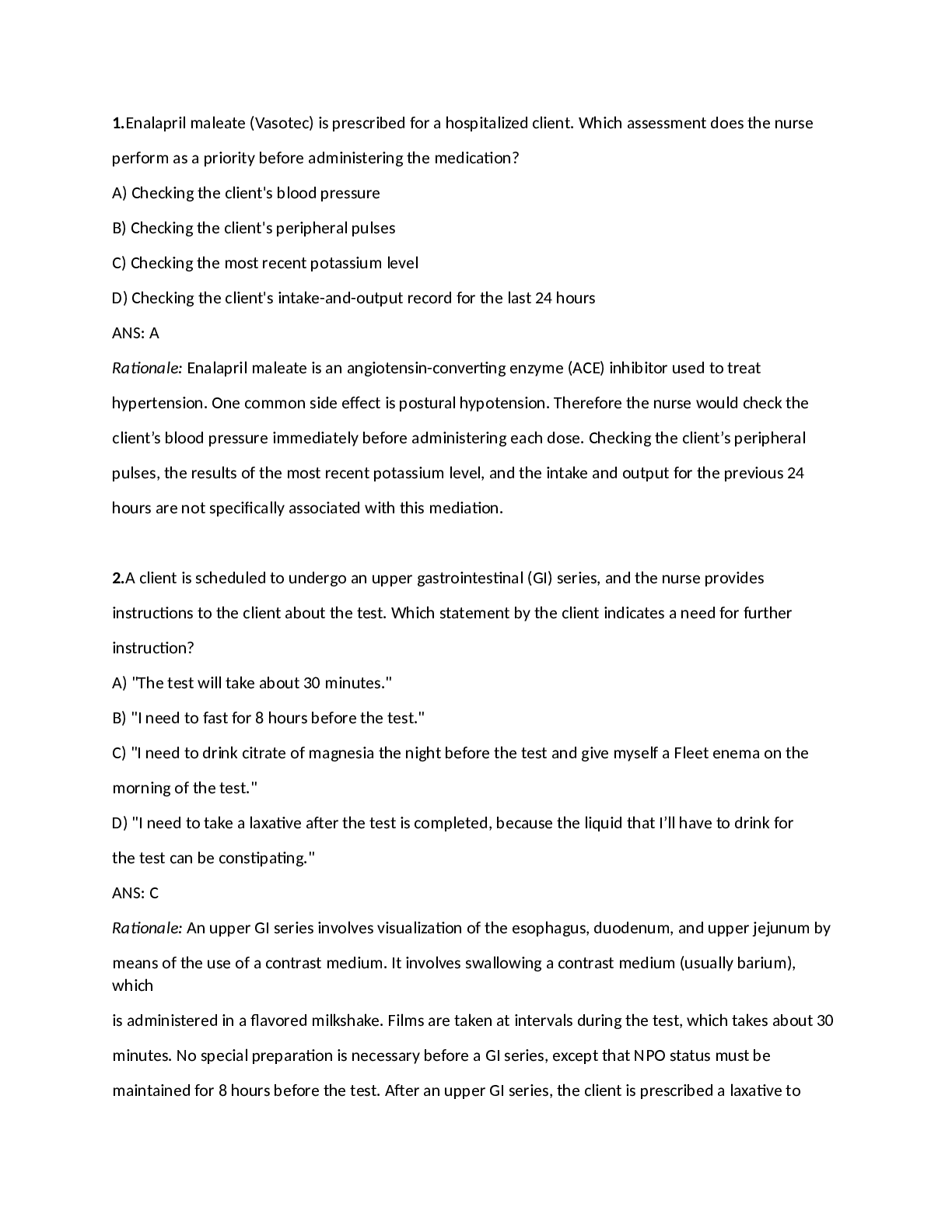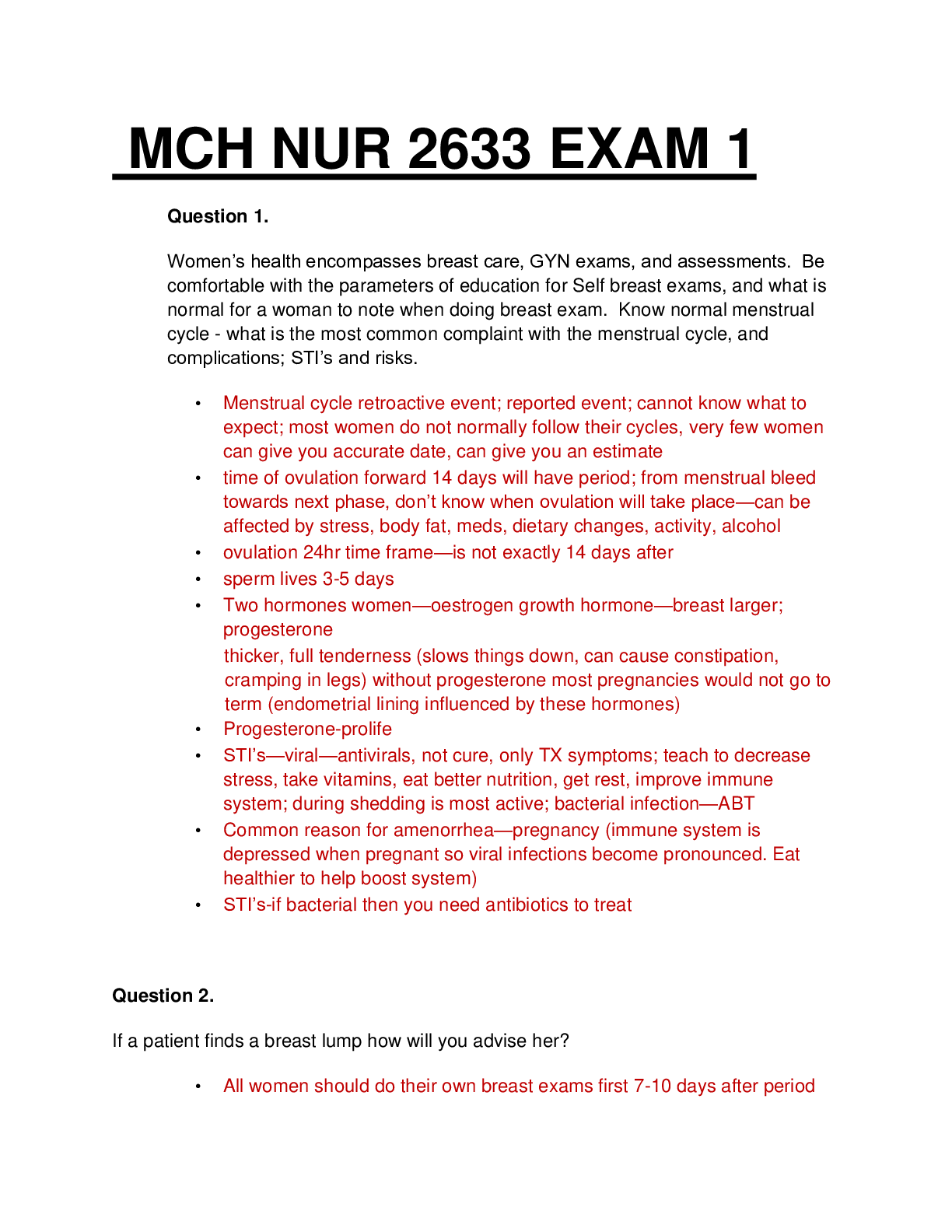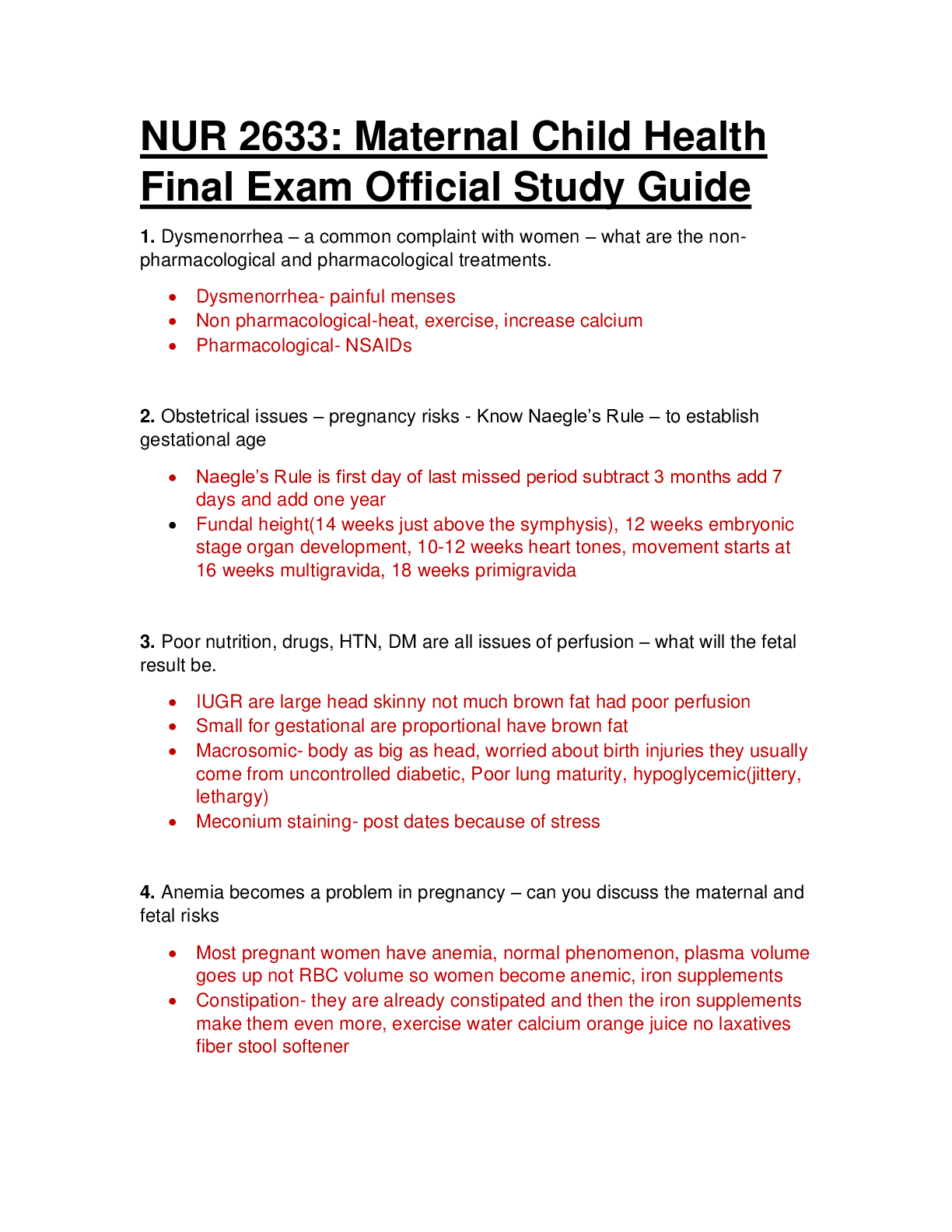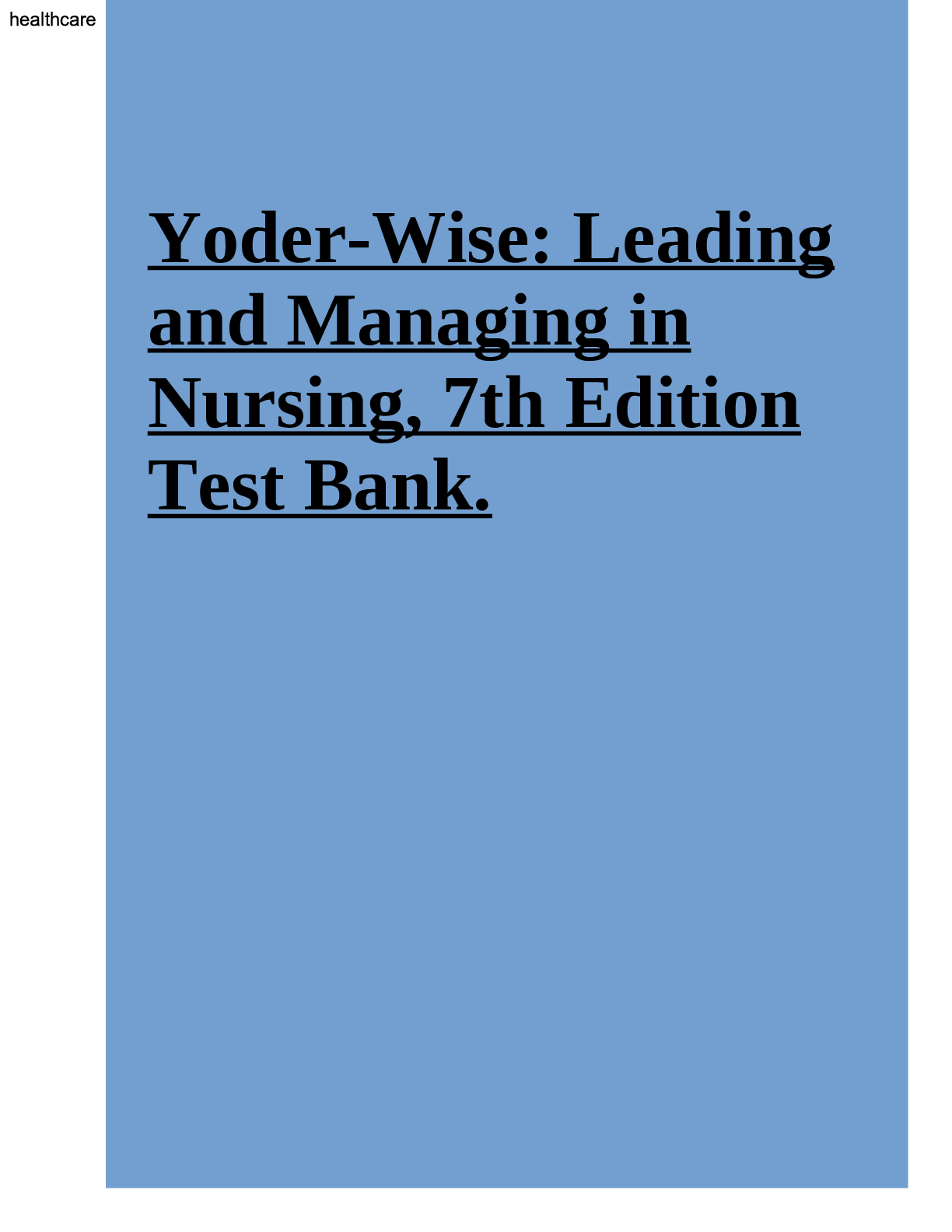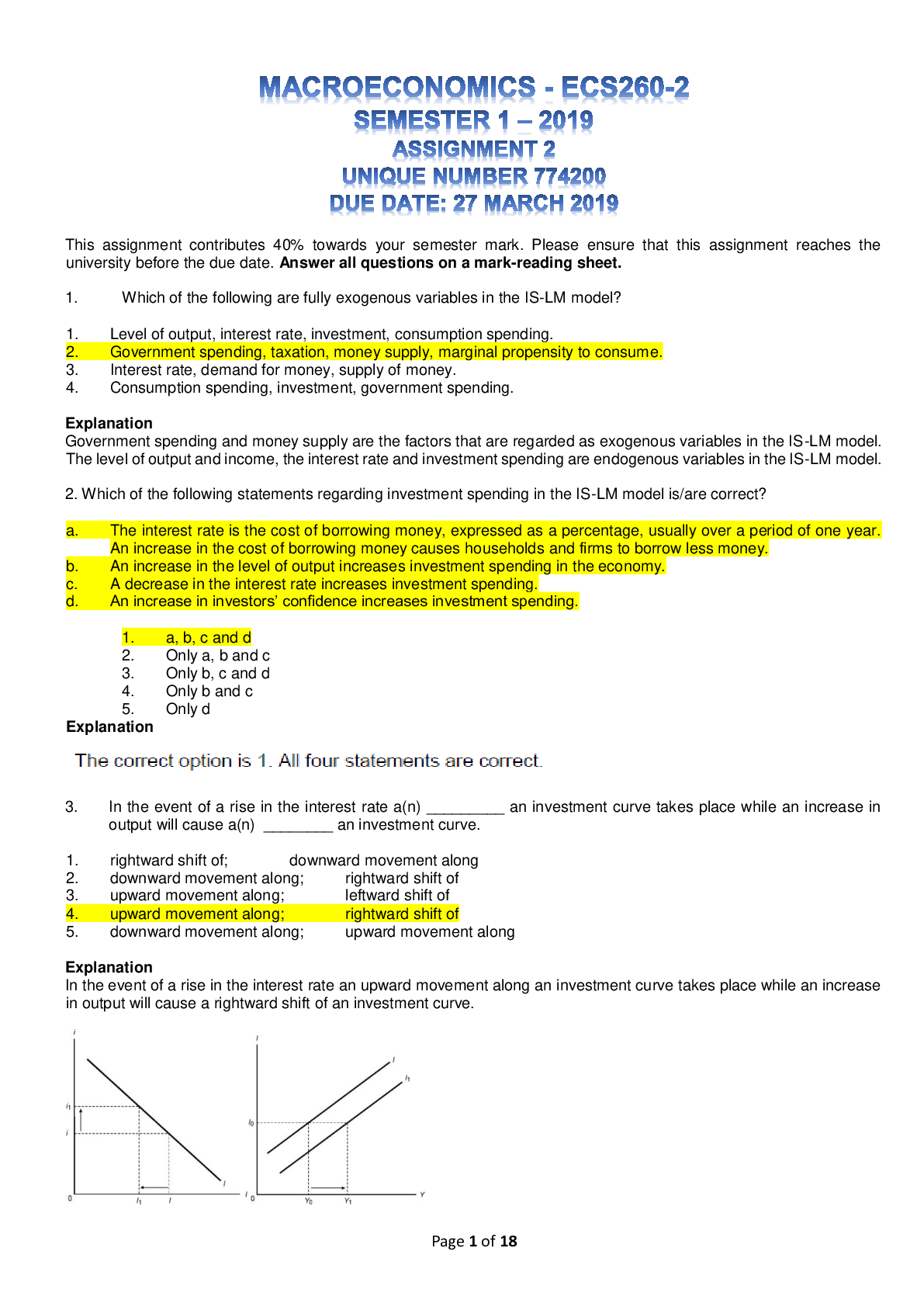*NURSING > EXAM > NURSING 320 OB-PREPU High Risk Labor | 100 latest questions with well explained answers. (All)
NURSING 320 OB-PREPU High Risk Labor | 100 latest questions with well explained answers.
Document Content and Description Below
OB-PREPU High Risk Labor 100 A multigravid client at 34 weeks' gestation visits the hospital because she suspects that her water has broken. After testing the leaking fluid with nitrazine paper, th... e nurse confirms that the client's membranes have ruptured when the paper turns which color? a) white b) red c) yellow d) blue A nurse is caring for a client with mild active bleeding from placenta previa. Which assessment factor indicates that an emergency cesarean birth may be necessary? a) Maternal heart rate of 65 beats/minute b) Fetal heart rate of 80 beats/minute c) Increased maternal blood pressure of 150/90 mm Hg d) Decreased amount of vaginal bleeding A laboring client with preeclampsia is prescribed magnesium sulfate 2 g/h IV piggyback. The pharmacy sends the IV to the unit labeled magnesium sulfate 20 g/500 ml normal saline. To deliver the correct dose, the nurse should set the pump to deliver how many milliliters per hour? Record your answer using a whole number. 50 mL/hour A client with eclampsia begins to experience a seizure. Which intervention should the nurse do immediately? a) Maintain a patent airway. b) Insert a padded tongue blade into the mouth. c) Pad the side rails. d) Place a pillow under the left buttock. A 24-year-old primigravid client in active labor requests use of the jet hydrotherapy tub to aid in pain relief. The nurse understands that which condition is a contraindication to hydrotherapy? a) ruptured membranes b) hypotonic labor patterns c) diabetes mellitus d) multifetal gestation During labor, a client's cervix fails to dilate progressively, despite her uncomfortable uterine contractions. To augment labor, the physician orders oxytocin. When preparing the client for oxytocin administration, the nurse describes the contractions the client is likely to feel when she starts to receive the drug. Which description is accurate? a) Contractions will be stronger and more uncomfortable and will peak more abruptly. b) Contractions will be stronger and shorter and will peak more slowly. c) Contractions will be stronger, shorter, and less uncomfortable. d) Contractions will be weaker, longer, and more effective. While a 31-year-old multigravida at 39 weeks’ gestation in active labor is being admitted, her amniotic membranes rupture spontaneously. The client’s cervix is 5 cm dilated, the presenting part is at 0 station, and the electronic fetal heart rate pattern is reassuring. What should the nurse do first? a) Auscultate the client's blood pressure. b) Prepare the client for imminent birth. c) Perform a vaginal examination to determine dilation. d) Note the color, amount, and odor of the amniotic fluid. When preparing a multigravid client at 34 weeks’ gestation experiencing preterm labor for the shake test performed on amniotic fluid, the nurse would instruct the client that this test is done to evaluate the maturity of which fetal systems? a) urinary b) pulmonary c) gastrointestinal d) cardiovascular Initial client assessment information includes: blood pressure 160/110 mm Hg, pulse 88 beats/minute, respiratory rate 22 breaths/minute, reflexes +3/+4 with 2 beat clonus. Urine specimen reveals +3 protein, negative sugar and ketones. Based on these findings, a nurse should expect the client to have which complaints? a) Diaphoresis, nystagmus, and dizziness b) Abdominal pain, urinary frequency, and pedal edema c) Lethargy, chest pain, and shortness of breath d) Headache, blurred vision, and facial and extremity swelling A client with hemolysis, elevated liver enzymes, and low platelet count (HELLP) syndrome is admitted to the labor and delivery unit. The client's condition rapidly deteriorates and despite efforts by the staff, the client dies. After the client's death, the nursing staff displays many emotions. With whom should the nurse-manager consult to help the staff cope with this unexpected death? a) The human resource director, so she can arrange vacation time for the staff b) The physician, so he can provide education about HELLP syndrome c) The chaplain, because his educational background includes strategies for handling grief d) The social worker, so she can contact the family about funeral arrangements and pass along the information to the nursing staff A multigravid client at 34 weeks’ gestation who is leaking amniotic fluid has just been hospitalized with a diagnosis of preterm premature rupture of membranes and preterm labor. The client’s contractions are 20 minutes apart, lasting 20 to 30 seconds. Her cervix is dilated to 2 cm. The nurse reviews the physician orders (see chart). Which of the following orders should the nurse initiate first? a) Administer betamethasone. b) Initiate fetal and contraction monitoring. c) Obtain the urine specimen. d) Start the intravenous infusion. A primigravida in active labor has been diagnosed with chorioamnionitis. After explaining this condition to the client, the nurse determines that the client understands the instructions when she says: a) “My baby's heart rate is slow because of my infection." b) “Women who are overweight are more likely to get this infection." c) “My infection is the cause of my hypertonic labor pattern." d) “If left untreated, my baby might be born with an infection." A primigravid with severe gestational hypertension has been receiving magnesium sulfate I.V. for 3 hours. The latest assessment reveals deep tendon reflexes (DTR) of +1, blood pressure of 150/100 mm Hg, a pulse of 92 beats/minute, a respiratory rate of 10 breaths/minute, and a urine output of 20 ml/hour. Which action should the nurse perform next? a) Increase the infusion rate by 5 gtt/minute. b) Stop the magnesium sulfate infusion. c) Decrease the infusion rate by 5 gtt/minute. d) Continue monitoring per standards of care. A client who is in her third trimester presents at the labor and delivery triage area with a history of a fall. She has bruising on her back and arms. There is no vaginal bleeding and the fetal heart rate (FHR) shows accelerations. A completed Abuse Assessment Screen indicates the possibility of abuse. The nurse should refer this client to: a) Women in Distress (local provincial/territorial, regional or aboriginal shelter). b) a lawyer. c) the social worker on call. d) the physician on call. Umbilical cord prolapse occurs after spontaneous rupture of the membranes. What should the nurse do immediately? a) Cover the cord with sterile towels. b) Ask the client to begin pushing. c) Administer oxytocin intravenously. d) Place the client in a Trendelenburg position. A primigravid client has just completed a difficult, forceps-assisted birth of a 9-lb (4.08-Kg) neonate. Her labor was unusually long and required oxytocin augmentation. The nurse who's caring for her should stay alert for: a) uterine discomfort. b) uterine involution. c) uterine inversion. d) uterine atony. A primigravid client at about 36 weeks’ gestation in active labor has had no prenatal care and admits to cocaine use during the pregnancy. Which person must the nurse notify? a) primary care provider who will attend the birth of the infant b) nursing unit manager so appropriate agencies can be notified c) chaplain in case the fetus dies in utero d) head of the hospital's security department A client is admitted at 30 weeks' gestation with contractions every 3 minutes. Her cervix is 1 to 2 cm dilated and 75% effaced. Following a 4-g bolus dose, IV magnesium sulfate is infusing at 2 g/h. How will the nurse know the medication is having the intended effect? a) Contractions will decrease in frequency, intensity, and duration. b) Contractions will increase in frequency, leading to birth. c) The client will maintain a respiratory rate greater than 12 breaths/min. d) The client will maintain blood pressure readings of 120/80 mm Hg. A 39-year-old multigravid client at 39 weeks' gestation admitted to the hospital in active labor has been diagnosed with class II heart disease. To ensure cardiac emptying and adequate oxygenation during labor, the nurse plans to encourage the client to: a) breathe slowly after each contraction. b) avoid the use of analgesics for the labor pain. c) remain in a side-lying position with the head elevated. d) request local anesthesia for vaginal birth. A term primigravida was involved in a car accident 3 hours ago. She is having labor contractions every 4 minutes, and her cervical exam is dilated 3cm, 100% effaced and station -1. She is crying uncontrollably and states her pain is constant and severe, rating it at 10/10. The priority action by the nurse is to: a) assess the intensity of contractions and determine if she would like an epidural. b) reassure the patient and assist with nonpharmacologic pain interventions. c) perform a vaginal examination and coach the woman with breathing exercises for pain control. d) notify the provider of the pain and request an assessment for potential abruption. A primigravid client in early labor with abruptio placentae develops disseminated intravascular coagulation (DIC). Which agent should the nurse expect the health care provider (HCP) to prescribe? a) warfarin sodium b) fresh-frozen platelets c) magnesium sulfate d) meperidine hydrochloride Following an epidural and placement of internal monitors, a client's labor is augmented. Contractions are lasting greater than 90 seconds and occurring every 1½ minutes. The uterine resting tone is greater than 20 mm Hg with an atypical fetal heart rate and pattern. Which action should the nurse take first? a) Increase the maintenance IV fluids. b) Turn off the oxytocin infusion. c) Turn the client to her left side. d) Notify the health care provider (HCP). A client with intrauterine growth restriction is admitted to the labor and birth unit and started on an I.V. infusion of oxytocin. Which aspect of the client's care plan should the nurse revise? a) Carefully titrating the oxytocin based on the client's pattern of labor b) Monitoring vital signs, including assessment of fetal well-being, every 15 to 30 minutes c) Allowing the client to ambulate as tolerated d) Helping the client use breathing exercises to manage her contractions A client is attempting to give birth vaginally despite the fact that her previous child was born by cesarean birth. Her contractions are 2 to 3 minutes apart, lasting from 5 to 100 seconds. Suddenly, the client complains of intense abdominal pain and the fetal monitor stops picking up contractions. The nurse recognizes which complication has occurred? a) Prolapsed cord b) Abruptio placentae c) Partial placenta previa d) Complete uterine rupture A multigravid client at 34 weeks' gestation with premature rupture of the membranes tests positive for group B streptococcus. The client is having contractions every 4 to 6 minutes. Her vital signs are as follows: blood pressure, 120/80 mm Hg; temperature, 100°F (37.8°C); pulse, 100 bpm; respirations, 18 breaths/minute. Which medication would the nurse expect the primary health care provider (HCP) to prescribe? a) intravenous gentamicin sulfate b) intravenous penicillin c) intramuscular cefaclor d) intramuscular betamethasone Due to a prolonged stage II of labor, the client is being prepared for an instrument-assisted birth. What information related to the mother and neonate's care must the nurse consider? a) Clients having instrument- assisted births are more likely to have postpartum hemorrhage. b) Using forceps will cause the neonate to develop a cephalhematoma. c) A vacuum extractor is safer than forceps because it causes less trauma to the neonate and the mother's perineum. d) Instrument-assisted births are very commonplace, especially in clients with epidurals. A nurse is evaluating a client who is 34 weeks pregnant for premature rupture of the membranes (PROM). Which findings indicate that PROM has occurred? Select all that apply. a) Acidic pH of fluid when tested with nitrazine paper b) Alkaline pH of fluid when tested with nitrazine paper c) Cervical dilation of 6 cm d) Contractions occurring every 5 minutes e) Fernlike pattern when vaginal fluid is placed on a glass slide and allowed to dry f) Presence of amniotic fluid in the vagina A multiparous client is admitted to the labor and delivery area with painless vaginal bleeding. Ultrasonography shows that an edge of her placenta meets but doesn't occlude the rim of the cervical os. This finding suggests: a) abruptio placentae. b) partial placenta previa. c) marginal placenta previa. d) a low-lying placenta. At 38 weeks' gestation, a primigravid client with poorly controlled diabetes and severe preeclampsia is admitted for a cesarean birth. The nurse explains to the client that childbirth helps to prevent which complication? a) perinatal asphyxia b) stillbirth c) congenital anomalies d) neonatal hyperbilirubinemia The nurse is reviewing the medical record of a multigravid client at 39 weeks' gestation with suspected HELLP syndrome. The nurse should notify the health care provider about which test result? a) lactate dehydrogenase (LDH) > 200 U/L (3.34 µkat/L) b) uric acid 3 mg/dL (178.4 µmol/L) c) aspartate aminotransferase (AST) 15 U/L (0.25 µkat/L) d) platelets 200,000 mm3 (200 X 109/L) When caring for a client with preeclampsia, which action is a priority? a) Monitoring the client's labor carefully and preparing for a fast delivery b) Continually assessing the fetal tracing for signs of fetal distress c) Reducing visual and auditory stimulation d) Checking vital signs every 15 minutes to watch for increasing blood pressure [Show More]
Last updated: 7 months ago
Preview 1 out of 7 pages

Buy this document to get the full access instantly
Instant Download Access after purchase
Buy NowInstant download
We Accept:

Reviews( 0 )
$6.00
Can't find what you want? Try our AI powered Search
Document information
Connected school, study & course
About the document
Uploaded On
Dec 15, 2020
Number of pages
7
Written in
Additional information
This document has been written for:
Uploaded
Dec 15, 2020
Downloads
0
Views
108

.png)





.png)



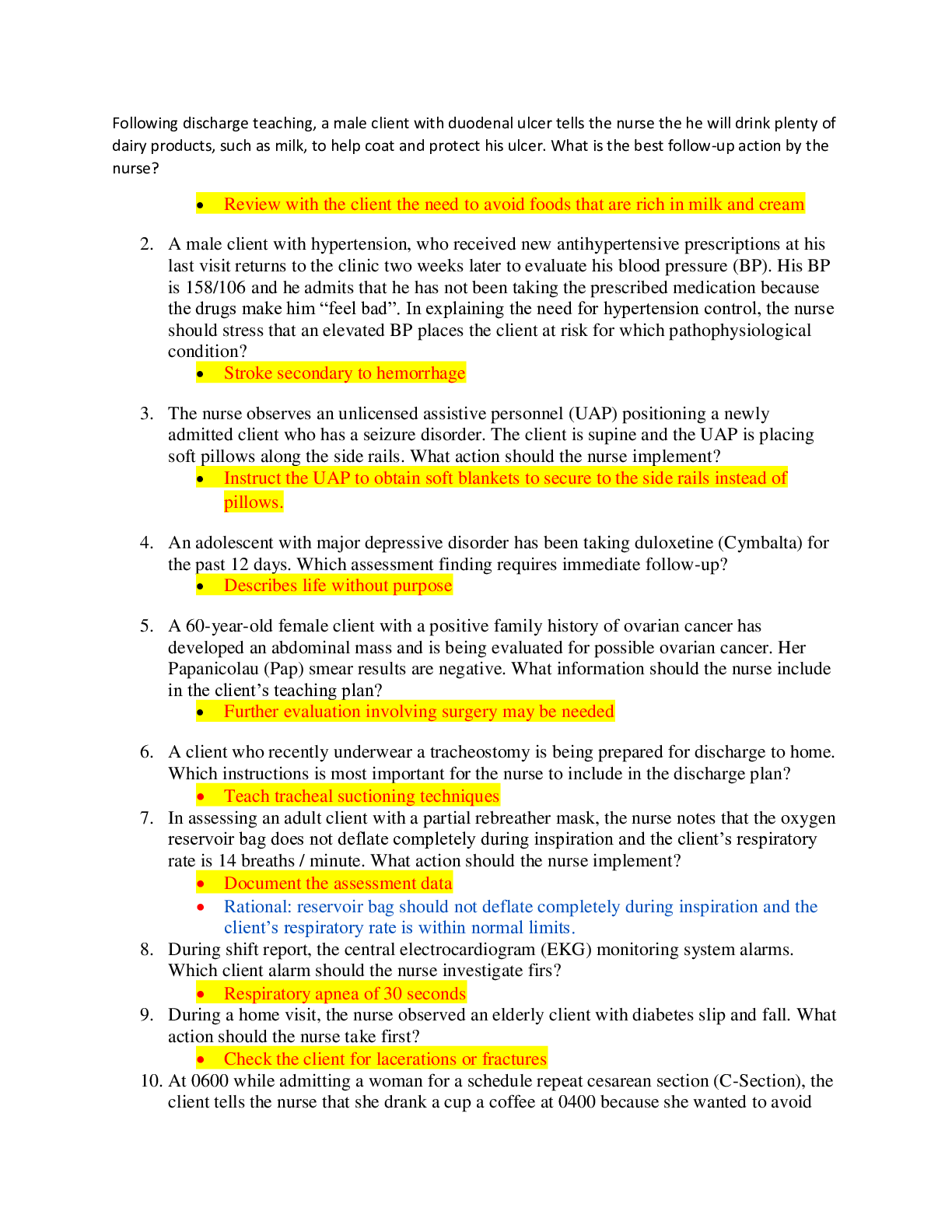
.png)

